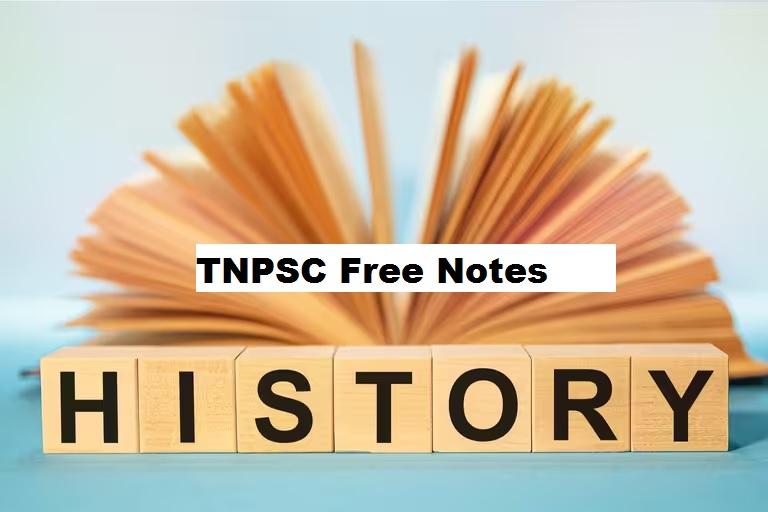இந்தக் கட்டுரையில், TNPSC குரூப் 1, குரூப் 2, குரூப் 2A, குரூப் 4 மாநிலப் போட்டித் தேர்வுகளான TNUSRB, TRB, TET, TNEB போன்றவற்றுக்கான முறைகள் இலவசக் குறிப்புகளைப் பெறுவீர்கள்.தேர்வுக்கு தயாராவோர் இங்குள்ள பாடக்குறிப்புகளை படித்து பயன்பெற வாழ்த்துகிறோம்.
Later Guptas
Chandragupta II was succeeded by his son Kumara Gupta I, who founded the Nalanda
University.
He was also called Sakraditya.
The last great king of the Gupta dynasty, Skanda Gupta, was the son of Kumara Gupta I.
The last recognised king of the Gupta line was Vishnu Gupta.
Administration of Guptas
Kings assumed titles such as maharajadhiraja, parama-bhattaraka and parameshvara.
They were also connected with gods through epithets such as parama-daivata (the
foremost worshipper of the gods) and paramabhagavata (the foremost worshipper of
Vasudeva Krishna).
Samudragupta is compared to Purusha (Supreme Being) in the Allahabad inscription.
These assertions can be seen as reflections of an attempt to claim divine status by the
king.
Ministers and other Officials
The term “kumaramatya” occurs in six Vaishali seals, which suggests that this title
represented a high-ranking officer associated with an office (adikarana) of his own.
The designation “amatya” occurs on several Bita seals, and the “kumaramatya” seems
to have been pre-eminent among amatyas and equivalent in status to princes of royal
blood.
One of the Vaishali seals refers to a kumaramatya who seems to have been in charge of
the maintenance of the sacred coronation tank of the Lichchavis.
Individuals holding the ranks of kumaramatya sometimes had additional designations as
well, and such ranks were hereditary.
For example, Harisena, composer of the Allahabad prashasti (inscriptions of praise), was
a Kumaramatya, Sandhivigrahika and Mahadandanayaka, and was the son of
Dhruvabhuti, a mahadandanayaka.
Council of Ministers
The Gupta king was assisted by a council of mantrins (ministers). The Allahabad
prashasti refers to an assembly or council, presumably of ministers, which was known as
the Sabha.
The various high-ranking functionaries included the sandhivigrahika or
mahasandhivigrahika (minister for peace and war), who seems to have been a high-
ranking officer in charge of contact and correspondence with other states, including
initiating wars and concluding alliances and treaties.
High-ranking officials were called dandanayakas, and mahadandanayakas were high-
ranking judicial or military officers.
One of the seals mentions a mahadandanayaka named Agnigupta. The Allahabad
prashasti refers to three mahadandanayakas. All these suggest that these posts were
hereditary by nature.
Another person had a designation mahashvapati (commander of the cavalry), indicating
military functions.
Division of the Empire
The Gupta Empire was divided into provinces known as deshas or bhuktis. They were
administered by governors who were usually designated as uparikas. The uparika was
directly appointed by the king and he, in turn, frequently appointed the head of the
district administration and the district board.
Uparika carried on the administration “with the enjoyment of the rule consisting of
elephants, horses and soldiers”, indicating his control over the military machinery as
well.
The fact that the uparika had the title maharaja in three of the Damodarpur plates
indicates his high status and rank in the administrative hierarchy.
The Eran pillar inscription of Budhagupta, dated Gupta year 165 CE, refers to maharaja
Surashmichandra as a lokpala, governing the land between the Kalinndi and Narmada
rivers. Lokpala here seems to refer to a provincial governor.
The provinces of the Gupta Empire were divided into districts known as visayas, which
were controlled by officers known as vishyapatis.
The vishyapatis seems to have been generally appointed by the provincial governor.
Sometimes, even the kings directly appointed the vishyapatis.
Prominent members of the town assisted the vishyapati in administrative duties.
Administrative Units below the District level
The administrative units below the district level included clusters of settlements known
variously as vithi, bhumi, pathaka and peta.
There are references to officials known as ayuktakas and vithi-mahattaras. At the village
level, villagers chose functionaries such as gramika and gramadhyaksha.
The Damodarpur copper plate of the reign of Budhagupta mentions an ashtakula-
adhikarana (a board of eight members) headed by the mahattara. Mahattara has a
range of meanings including village elder, village headman, and head of a family
community.
The Sanchi inscription of the time of Chandragupta II mentions the panch-mandali,
which may have been a corporate body.
Army
Seals and inscriptions mention military designations such as baladhikrita and
mahabaladhikrita (commander of infantry and cavalry).
The standard term “senapati” does not occur in Gupta inscriptions, but the term could
be found in some Vakataka epigraphs.
A Vaishali seal mentions the ranabhandagaradhikarana, which is the office of the
military storehouse.
Another Vaishali seal mentions the adhikarana (office) of the dandapashika, which may
have been a district-level police office.
The officials connected specifically with the royal establishment included the
mahapratiara (chief of the palace guards) and the khadyatapakita (superintendent of
the royal kitchen).
A Vaishali seal mentions a person both as a mahapratihara and a taravara. The top layer
of the administrative structure also included amatyas and sachivas, who were executive
officers in charge of various departments.
The system of espionage included spies known as dutakas.
The ayuktakas were another cadre of high-ranking officers.
**************************************************************************
| Adda247 TamilNadu Home page | Click here |
| Official Website=Adda247 | Click here |








